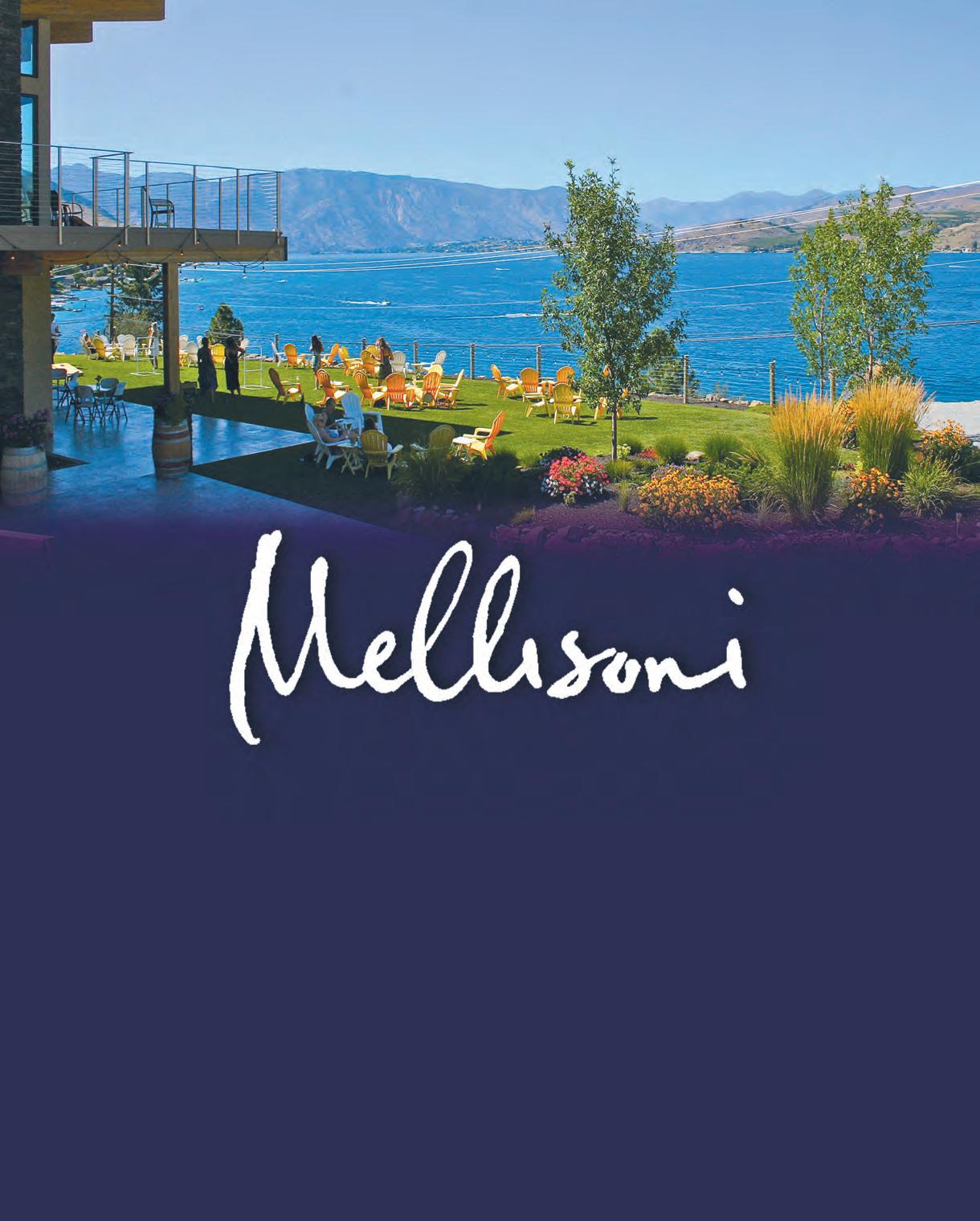
6 minute read
Puget Sound winery earns honors
blackberry bushes, but located on about a 300-foot-high slope.
“It was the great drainage, with great southwest exposure that made me want to buy that piece,” Chuck said. Beyond that, spectacular sunset views of the valley and nearby Anacortes and the San Juan Islands were an added bonus.”
Advertisement
It took the Jacksons two years to clear and develop the property, which now includes their home. The first vineyards were planted in 2011. Initially there were six acres of wine grapes but that has since been pared to what the Jacksons said they feel is a more manageable three.
A WESTSIDE VINEYARD WITH A FEW SURPRISES
The choice of varieties to plant in the Puget Sound AVA comes with its own set of climatic limitations; potentially too-cool summers, excessive rain, and in 2020, the threat of smoke from fires outside the state.
For Chuck, planting Pinot Noir was a natural choice, but his choice of white wine grapes could be considered unconventional for the Puget Sound.
“What you normally find (grown) in the Puget Sound region is Madeleine Angevine and Siegerrebe,” he says. “And as much as they make wonderful wine, most people are not familiar with them. So the varieties we ended up planting were the ones I always enjoyed as a wine drinker and people would also recognize their names.
“What we did to be successful at that was to choose the earliest ripening clones we could find. (And we) chose plants that were grafted to root stock that were also shown through research at WSU to advance earlier ripening.”
With just enough heating units at their location, Skagit Crest is able to grow Chardonnay, Pinot Gris, Pinot Blanc and Sauvignon Blanc on half of their vineyard. The other half includes four clones of Pinot Noir: Précoce, Dijon 114 and 777, and Pommard. Chuck notes that a few other Pinot Noir clones may be in the offing, along with Grüner Veltliner, an Austrian variety that’s always intrigued him.
The Jacksons opened up their tasting room in downtown LaConner in 2017. Its cozy, waterfront location is a perfect stop for those strolling along the town’s Swinomish Channel.
While Chuck gets credit for much of the technical composition that goes into winemaking, he’s quick to acknowledge Donna’s contributions to the finished product. “She’s invaluable as a check on me because she’s more keyed into what people like.” That even applies to the Pinot Noir juice she makes for kids to sample while their parents visit the tasting room.
Skagit Crest’s tasting menu currently features each of the estate-grown white varietals, plus a blend of all four bottled as “Chuckanut White.” Red wines include their flagship wine, Pinot Noir, produced both as a standalone varietal and in a Rosé style; and a red blend, Syrah, and Cabernet Sauvignon, sourced from vineyards in Eastern Washington’s Horse Heaven Hills and Yakima Valley Appellations. 2020 was a particularly good year for Skagit Crest, which produces 500-600 cases annually, having earned four golds and a double gold medal from the Seattle Wine Awards competition. And then there’s that extra-special, Double Platinum-worthy 2017 Pinot Noir. Chuck recalls that it wasn’t a particularly outstanding vintage, but there were decent heat units, the weather held through harvest and the grapes had excellent pH and brix levels.
“Blending all four (Pinot Noir) clones gave us just the right balance,” he says. “It was essentially a ‘hands-off’ year and it turned out to be magic.”
Magic? Good fortune? The saying, “Luck is the residue of design,” is probably more appropriate for Chuck Jackson’s wines. Factor in decades of experience, a beautiful vineyard location and good-old fashioned stick-toitiveness, and the end result is a retirement gig that’s paying much-deserved dividends with award-winning wines.
SKAGIT CREST VINEYARD & WINERY
Vineyard: Located in Sedro-Woolley and available for private tastings by appointment only
Tasting Room: 105 North First Street, Suite 1
LaConner, WA 98257
Hours: Noon to 5 pm, Saturday and Sunday
(360) 333-9819, www.skagitcrest.com




INNOVATION IS THE KEY TO UNIQUE LIMITED ADDITION WINES
By Tamara Belgard
FOREST GROVE, ORE. — n a practice that is hundreds of centu-
Iries old, employing new techniques is often not easy, or at least not easily embraced. That’s especially true in Old World wines, with their traditional methods perpetuated generation after generation. But in the New World, innovation is generally well received, especially in the Northwest, where traditions are at most decades old.
Limited Addition (Ltd +) could easily be the poster child for a brave new world of wine innovation in Oregon’s Willamette Valley.
Chad and Bree Stock, a husband and wife team, have merged their superpowers and unique backgrounds in wine to create Ltd+, which emerged as a collaboration with area farmers inspired to develop a diverse and sustainable wine landscape. The wines, often made from less common grape varieties adopting innovative techniques, are changing preconceived notions of Oregon wine.
Their first vintage included a 2018 Pinot Noir/Pinot Gris blend, which is unusual to say the least. The wine was co-fermented to bring acidity, spice and elegance, creating a balanced wine. Pinot Noir has a high pH in the Willamette Valley, and some winemakers mitigate this by adding acid during production. But Ltd.+ takes a more natural approach. So, much in the way that Viognier is co-fermented with Syrah, Chad and Bree thought adding Pinot Gris would help balance the pH and the dense, structured and dark Pinot Noir they were working with from the Amity Hills. For the same reasons, Ltd+ also blends in Gamay.
It was a moment of winemaking when they experimented and trusted their intuition. Despite being classically trained — Chad has an enology degree from California State University Fresno and Bree holds the international qualification Master of Wine — their winemaking philosophy is less grounded in tradition and more about seeing what tastes good and letting that guide them.
Other parts of the world are known for their blends such as Bordeaux, GSMs, and Super Tuscans, but in the Willamette Valley, blending is less common. Though blends and field blends are prominently found all over the world, American consumers have an obsession with varietal purity.
“Five percent of wines are great as a single varietal expression,” Chad says. “The blends allow us to bring out the best instead of being rooted in individual isolation.” He argues that with education, experimentation and experience, a winemaker can create better and more interesting wines. “The more we educate, the more we can do.”
They are most interested in expanding the conversation around wine style and regional expression, so they seek out grapes atypical to the region they work in, choosing to make Grenache in the Willamette Valley. And, when they work with such traditional Oregon grapes as Pinot Noir, they aim to expand conventional thinking of a style, variety or place. Ltd+ commonly uses conventional varieties in its blends, compound fermentations, fermentation on skins for white grapes, partial carbonic fermentation, foot treading, a shorter time on the skins and multi-vessel fermentations and maturation.
Take, for example, their Grenache Rosé. Rather than recreating the conventional pale dry rosé a la Provencale, their wine aims to extend the narrow category of rosé globally by being neither typical Grenache, nor typical rosé.
“The Grenache, which is rarely seen grown in a cool-climate like the Willamette Valley, is picked at an earlier ripeness level than is typical for Grenache from a hotter region and fermented for a short time wholecluster,” he says. The result is intensely aromatic, with Campari and Amaro-type qualities, and a peppery spice — one of the most exciting wines in the cellar.
“Even though this year was only moderately warm,” he adds, “we are still able to ripen Grenache, a traditionally hot climate variety, in the Willamette Valley”
Ltd+ produces a field blend of Cabernet

Photo by Limited Addition
Chad and Bree Stock display some of the fermenters they use in their wine program, including puncheons, Novum amphora, Chablis barrels, a very large Austrian oak foudre, and specialty Bordeaux barrels.




